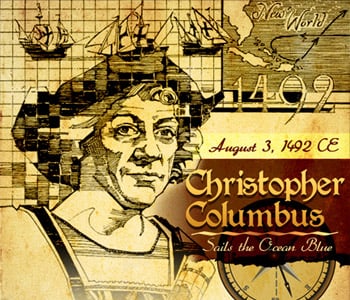Click to view full Infographic After seven years of attempting to secure funding and disappointment after disappointment, Christopher Columbus set sail on his infamous voyage to the New World on August 3, 1492. Though the Europeans had arrived five centuries before when the Norse landed in modern Canada, the Italian sailor’s expedition from Palos, Spain opened the door to waves of European exploration and settlement over the course of several centuries. Columbus moved to find a western trade route to the Orient by approaching the King of Portugal, John II in 1485. Proposing he be given a year to sail three ships out and return, Columbus further requested the title “Great Admiral of the Ocean Sea” – the name for the Atlantic Ocean in his day – and a ten percent share of all profits from whatever lands he discovered, as well as being appointed governor of them. Interested in the potential financial rewards, particularly as the land route to Asia had become treacherous after the Ottomans captured Constantinople three decades before, the king passed the plan on to his advisors for their review. Believing his estimates of the distance to be off, the experts recommended John II deny the proposal. (Columbus believed there were only 2,400 miles to sail; there are actually more than 4,000.) Undiscouraged, the sailor from Genoa returned to the court of John II three years later with a similar proposal. Turned down a second time, likely due to Bartolomeu Dias’ rounding of the tip of Africa, Columbus sought other partners for the voyage, sounding out officials in two Italian cities, as well as the kings of England and France. Though initially rebuffed by King Ferdinand and Queen Isabella, due to similar concerns about the maritime gap between Spain and Asia, Columbus benefited from the Queen’s desire to hold on to his ideas. In order to persuade Columbus to stay, she offered him an annual allowance and arranged for him to have food and housing anywhere in Castile at no cost. After a further two years of meetings and ample negotiations, Columbus’ petition was granted. He would be named Admiral of the Ocean Sea, receive the title of Governor and acquire a generous percentage of the revenue, though not the ten percent he had requested. (Columbus’ son would later write the king and queen did not expect his father to return.) Having already secured half the financing from Italian investors, Columbus used the funds from Spain to hire crew and get three ships – the Nina, Pinta and Santa Maria, all property of Palos residents. Leaving on August 3, 1492, the expedition sailed for the Canary Islands off the western coast of Africa. A month later, after restocking and making repairs on the Castillian island of La Gomera, Columbus and his crew set sail on September 6th from San Sebastian de la Gomera. Thirty-six days later, Columbus and his men arrived in the Bahamas, the first of a new wave of European explorers to set foot in the Americas.
August 3, 1492 CE – Christopher Columbus Sails the Ocean Blue
Click to view full Infographic After seven years of attempting to secure funding and disappointment after disappointment, Christopher Columbus set sail on his infamous voyage to the New World on…
612
